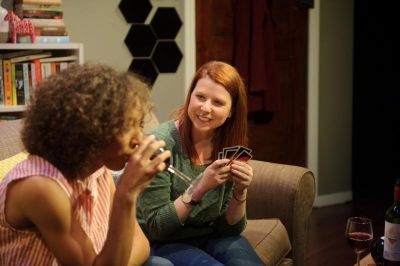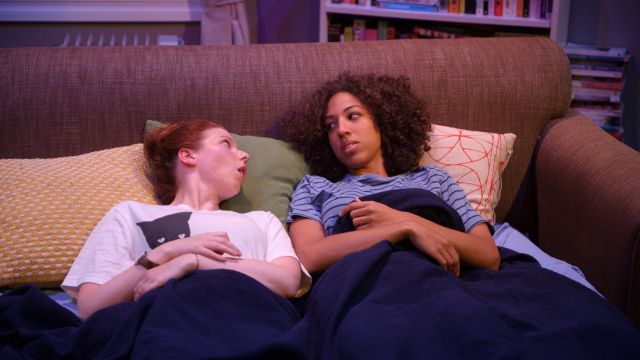Stop Kiss
Here is a love story that pivots on an act of violence. Near dawn in a New York park, Callie and Sara finally reveal what both want - their first kiss. And some misogynistic man looms out of the darkness and attacks them. The violence is not the climax, or even, really, the subject; it is in a way the beginning, a sort of catalyst that opens the unexpected.
The play alternates and juxtaposes scenes of the tentative, touching, often funny progress of Callie and Sara’s relationship - from their first meeting to the night of the attack - with the aftermath of the attack itself. Broken, comatose Sara in hospital, guilty Callie forcing herself to approach the bedside, blame-the-victim police interviews, unwanted newspaper stories, Sara’s past lover Peter coming to ‘claim’ her and take her ‘home’ to St Louis, and Callie’s choice to commit – or not – for the first time in her life.
First performed in New York City in 1998 and revived several times since, Stop Kiss could come across as a period piece. Surely, some might say, we’re all raunchier, all more up-front these days? And yet, the predicament (if that’s the word) of these two ‘straight’ young women, who must take the leap not just of admitting their feelings for each but acting on them, could certainly happen now – as certainly could the violence enacted on them.
 Director Byron Bache has assembled a great cast. Cazz Bainbridge gives a finely detailed performance as the vacillating, self-deprecating, dry witted Callie – although as a New Yorker for eleven years, she might be tougher and a little more speedy. Tamiah Bantum has a sweetness that engages within seconds; she gives Sara naiveté, idealism and courage as drive-straight-ahead Sara. Both performers, however, could realise that acting ‘sincerity’ does not mean becoming inaudible – and the sexual attraction, no matter how inhibited, could be clearer.
Director Byron Bache has assembled a great cast. Cazz Bainbridge gives a finely detailed performance as the vacillating, self-deprecating, dry witted Callie – although as a New Yorker for eleven years, she might be tougher and a little more speedy. Tamiah Bantum has a sweetness that engages within seconds; she gives Sara naiveté, idealism and courage as drive-straight-ahead Sara. Both performers, however, could realise that acting ‘sincerity’ does not mean becoming inaudible – and the sexual attraction, no matter how inhibited, could be clearer.
The supporting cast is all totally credible and serve the text admirably. Mathew Young is George, Callie’s ‘friend with benefits’, a kind of likeable slacker. James Rosier is Peter, the man Sara outgrew back in St Louis – and Mr Rosier plays it with a sort of dogged intensity that makes us see why. Thomas Kay plays the skeptical detective with great presence and a nice feel for subtext in his brief scenes. Lindy Yeates is totally credible as the woman who saw the attack from her window and called the cops, and she’s the sympathetic nurse who sees that Sara and Callie are a couple (or will they be?) without being told.
Diana Son is the author of five plays, but is also a series television writer. Stop Kiss, an entirely naturalistic work,does resemble a screenplay in its flashing back and forward in often short – sometimes very short – scenes, each time changing location and costume. Given that, director Byron Bache and designer Nick Casey have made what are to me some unfortunate choices.
I would have thought that a delicate, naturalistic work with a fragmentary, non-linear structure, requires seamless transitions and therefore momentum for unbroken audience engagement. Perhaps paradoxically, it doesn’t need naturalistic settings. This production, however, employs a revolve (and a slow, rumbling one at that) so that each of the five or six ‘locations’ has its own set. Callie’s apartment is the most dressed and the most used. In addition, each scene appears to require a costume change. Ms Bantum (Sara) disappears into the wings, but a wardrobe assistant appears on stage and in full view assists Ms Bainbridge to change – and sometimes into a costume for a scene lasting only a minute or less. (No criticism of the wardrobe per se: Nico Wilsdon has chosen absolutely character appropriate costumes.)
 I’m reminded of the first production, by the STC, of a very fine Australian play, The Blind Giant Is Dancing. When playwright Stephen Sewell (who also writes fragmented pieces with often short, sharp scenes) turned up for the first tech run, he saw that they were using a revolve. Why? Because there’s so much furniture we have to get on and off. No, said Mr Sewell, what you need is a pool of light there… and then a pool of light here… and if the actor needs a chair, she can carry it on. But no. The revolve stayed, with predictable consequences: rumble-rumble, breaking flow, losing momentum and losing audience engagement. When the play was revived, at Belvoir, there was no revolve and almost no furniture. Both productions had top quality cast, but the latter was far superior – it went like a train and left you breathless.
I’m reminded of the first production, by the STC, of a very fine Australian play, The Blind Giant Is Dancing. When playwright Stephen Sewell (who also writes fragmented pieces with often short, sharp scenes) turned up for the first tech run, he saw that they were using a revolve. Why? Because there’s so much furniture we have to get on and off. No, said Mr Sewell, what you need is a pool of light there… and then a pool of light here… and if the actor needs a chair, she can carry it on. But no. The revolve stayed, with predictable consequences: rumble-rumble, breaking flow, losing momentum and losing audience engagement. When the play was revived, at Belvoir, there was no revolve and almost no furniture. Both productions had top quality cast, but the latter was far superior – it went like a train and left you breathless.
Perhaps Mr Bache and Mr Casey figured they were stuck with the many changes of scene and wardrobe and so decided to make a feature of it – as in, ‘look, we’re doing this on purpose.’ Perhaps the rationale is a sort of alienation thing – a reminder that we’re watching a play. But Stop Kiss is not that sort of play. As remarked, these choices are unfortunate. They disengage and they make the show seem far longer than its ninety minutes. Even more unfortunate in that the text, while not robust, is subtle, finely detailed and beautifully observed – and delivered with great delicacy by the cast. It survives the revolve and even the costume changes, so it is still very much worth seeing – a Midsumma presentation which, by being very specific, speaks to all.
Michael Brindley
Photographer: Sarah Walker.
Subscribe to our E-Newsletter, buy our latest print edition or find a Performing Arts book at Book Nook.

